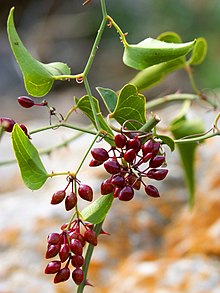| Smilax ornata | |
|---|---|

| |
| Scientific classification | |
| Kingdom: | Plantae |
| Clade: | Tracheophytes |
| Clade: | Angiosperms |
| Clade: | Monocots |
| Order: | Liliales |
| Family: | Smilacaceae |
| Genus: | Smilax |
| Species: | S. ornata
|
| Binomial name | |
| Smilax ornata | |
| Synonyms[2] | |
| |
Smilax ornata is a perennial trailing vine with prickly stems that is native to Mexico and Central America.[3] Common names include sarsaparilla,[4] Honduran sarsaparilla,[4] and Jamaican sarsaparilla.[4]
It is known in Spanish as zarzaparrilla, which is derived from the words zarza meaning "bramble" (from Basque sartzia "bramble"), and parrilla, meaning "little grape vine".[5][6][7][8][9]
Smilax ornata is used as the basis for a soft drink frequently called sarsaparilla. It is also a primary ingredient in old fashioned-style licorice,[10] in conjunction with sassafras,[11] which was more widely available prior to studies of its potential health risks.[12]
Smilax ornata was considered by Native Americans to have medicinal properties, and was a popular European treatment for syphilis when it was introduced from the New World.[13] From 1820 to 1910, it was registered in the U.S. Pharmacopoeia as a treatment for syphilis.[citation needed]